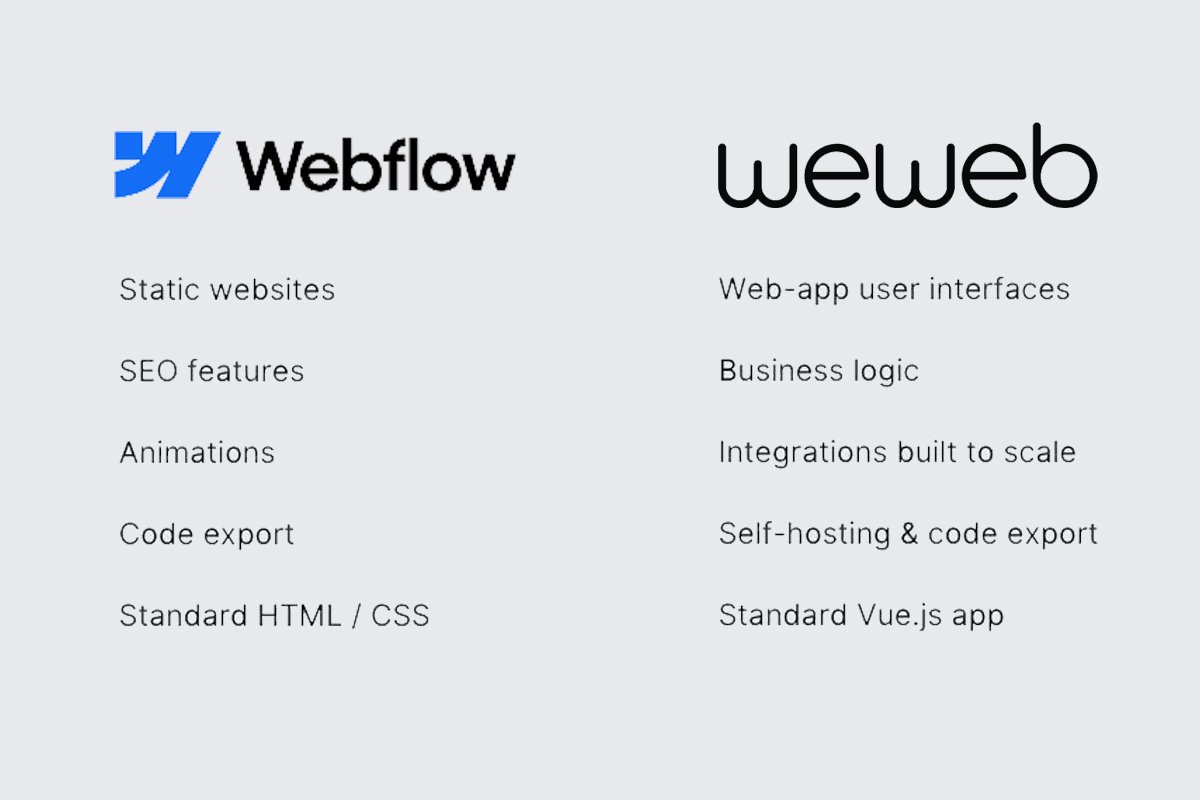In the era of no-code and low-code development, platforms like Webflow and WeWeb are gaining massive traction. These tools empower designers, marketers, and even developers to create powerful websites and web applications without writing extensive code. While they serve similar audiences, their core strengths and ideal use cases vary significantly.
In this article, we’ll explore:
- What Webflow and WeWeb are
- A direct comparison of their features
- Pros and cons of each
- Which platform suits which type of project
What is Webflow?
Webflow is a visual web design tool, CMS, and hosting platform that allows users to design, build, and launch responsive websites with pixel-perfect precision — all without needing to write code. It combines the power of HTML, CSS, and JavaScript in a visual canvas, giving full control over styling and layout.
Key Features:
- Visual drag-and-drop builder
- Built-in CMS (Content Management System)
- E-commerce capabilities
- Hosting and SSL included
- Custom animations and interactions
- Figma-style design flexibility
Webflow is often described as a mix of WordPress, Figma, and a code editor, tailored for designers who want production-ready websites.
What is WeWeb?
WeWeb is a no-code front-end builder for creating data-driven web applications. It’s more focused on building dynamic, reactive web apps with complex logic and integrations, especially suited for connecting to back-end tools like Xano, Airtable, or REST APIs.
Key Features:
- Front-end builder for web apps
- Built-in logic, variables, and conditional rendering
- Connects seamlessly to back-end services
- Custom workflows and dynamic routing
- Component-based interface
- Publish as static or dynamic web apps
WeWeb is more oriented toward internal tools, dashboards, and web apps than simple marketing websites.
Side-by-Side Comparison
| Feature | Webflow | WeWeb |
| Target Audience | Marketing websites, portfolios, and e-commerce | Developers, startups, internal tool builders |
| Best For | Marketing websites, portfolios, e-commerce | Web apps, dashboards, client portals |
| Visual Design | High-fidelity control, like Figma | Basic layout tools, focused on functionality |
| CMS | Built-in, easy-to-use CMS | Relies on external databases (Airtable, Xano, Supabase) |
| Backend Integration | Limited (via third-party tools like Zapier, Make) | Built-in logic, conditions, variables, and state management |
| Custom Logic | Limited (needs custom JS or third-party tools) | Built-in logic, conditions, variables, state management |
| E-commerce | Native e-commerce support | Not natively supported |
| Code Export | Yes (HTML, CSS, JS) | Yes (as a static front-end or headless app) |
| Hosting | Webflow-hosted | WeWeb-hosted or export to your own |
| Pricing | Starts free, scales with site needs | Built-in logic, conditions, variables, and state management |
Pros and Cons
Webflow
Pros:
- Excellent for visual design and pixel-perfect layouts
- Built-in CMS for blogs, landing pages, and content-driven sites
- Powerful animation and interaction tools
- Great for SEO and static site performance
- Reliable hosting and support
Cons:
- Limited back-end or dynamic logic capabilities
- Not suitable for building complex apps or portals
- Learning curve if you’re not familiar with front-end principles
WeWeb
Pros:
- Ideal for dynamic web apps and internal tools
- Strong API and back-end integrations
- Built-in logic and workflows
- Component-based architecture for app-level control
- Can connect to real-time data sources
Cons:
- Not as design-focused or visually flexible as Webflow
- Requires more planning and understanding of back-end logic
- No built-in e-commerce or blogging capabilities
- Smaller community than Webflow (as of now)
Which is Better for Which Type of Website?
Use Webflow if you want to build:
- Marketing websites
- Landing pages
- Design-driven portfolios
- Blogs or CMS-powered content sites
- Simple e-commerce stores
- Sites with a high need for animations and UI polish
Use WeWeb if you want to build:
- Web applications or SaaS front-ends
- Admin dashboards
- Client or user portals
- Internal business tools
- Dynamic pages based on user data or API responses
- Front-end for back-end services like Xano, Supabase, etc.
Final Thoughts
Choosing between Webflow and WeWeb comes down to one key question:
Are you building a marketing website or a web application?
- For visual polish, CMS features, and fast marketing sites, Webflow is hard to beat.
- For building real, interactive web apps with complex logic and back-end integration, WeWeb is the better choice.
Both tools are powerful, but their strengths lie in different domains.
If you’re still unsure, consider trying both on a small project to see which fits your workflow better. Want help picking the best tool for your specific idea? Let me know what you’re building — I can help you decide!


